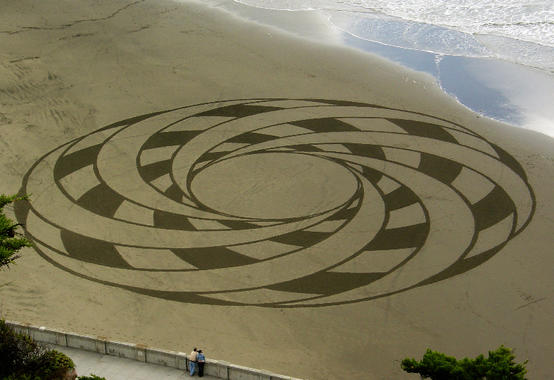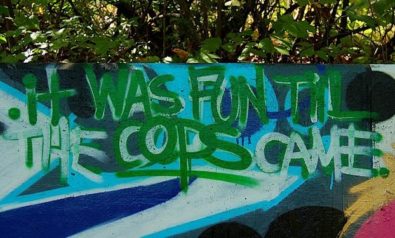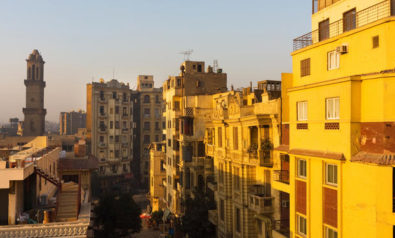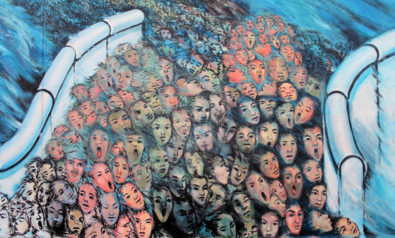Artist Bianca Nandzik looks at the progression of land art from monumental works cut into the earth’s landscape towards a quieter, more ephemeral art form. [View the photo feature, Rethinking “Land Art“.]
In the late 1960s, a group of artists protested against the conventional market-driven art world. They turned their back on museums and galleries and began to explore nature as their canvas. A new art form was born, which became known as “earth art” or “land art”. Their works demonstrate how the artists dealt with technological, social and political conditions. The pioneers of land art put momentous construction efforts in their projects. Using bulldozers, cranes and dynamite, their artworks were a violent act of creation. It showed the human need to create something spectacular.
History is Alive
Monumental artworks from American artists like Michael Heizer’s “Double Negative” (1969) near Overton in the Nevada desert shaped our understanding of this movement. He removed 244,000 tons of rock to make two trenches, which cover an area 1,500 feet long. The cuts present an object, created by displacement — a man-made negative space that leaves an impressive emptiness. Heizer does not wish to restore “Double Negative”. On the contrary, he wants nature to reclaim the land. Recently, he chose not to participate at the Los Angeles’s MOCA exhibition “Ends of Earth,” which was shown until January 2013 at the Haus der Kunst in Munich. He was worried that the documentation in a museum misrepresents his artwork, and suggested that the spectator should rather experience it physically to feel the essence of the work.
Since the artworks are exposed to weather and erosion, it is quite impressive that early masterpieces such as Robert Smithson’s “Spiral Jetty” (1970) are still clearly visible today. He built a 1,500-foot-long spiral with heavy construction equipment on the northeastern shore of the Great Salt Lake in Utah. He used mud and local basalt rocks for this massive earthwork sculpture in the red shimmering water. After over 40 years, the originally black basalt rock changed due to different water levels and salt encrustation. It is largely white against pink now. The extraordinary shape can be seen on Google Earth.
Another imposing land art installation from the early days is Walter De Maria’s “Lightning Field” (1977) on a desert plateau of the northern Catron County, New Mexico. He placed 400 stainless steel poles in a rectangular grid of one mile long and one kilometer wide. The perfect man-made three-dimensional grid with solid pointed tips that defines a horizontal plane, stands in contrast to the natural landform. It attracts spectacular lightning strikes and manifests the elemental power of nature. The first significant restoration work is taking place right now, after almost 35 years. According to the Dia Art Foundation, the “Lightning Field” will reopen for visitors this summer.
A New Generation
Since its conception in the 1960s, the meaning of the term “land art” has changed. Today, artists have different impulses and goals. The current focus is less on monumental artworks in remote places under the open sky. The new generation of land artists makes impermanent interventions. They investigate their relationship to the natural environment. Their work is often inspired by nature, but not necessarily by a reaction to urbanization. They don’t intend to convey any particular message in their work. Since the temporary aspect is more present in their projects, platforms like photography, film and the Internet become very important.
One of the new-generation artists is California-based Andres Amador. Since 2004, he paints large-scale geometric and organic patterns with a stick and a rake into beach sand. In the first few years he used geometric patterns as seen in his piece “Flower of Life”. They reflect perfection but are largely independent – like a stamp in the landscape. Later on, he started to research organic patterns, which would embrace nature’s imperfection. These complex organic shapes respond to what the beach landscape offers. He describes his work as a “Design Nature Math Philosophy” because his shapes find explanation in chaos theory, fractals, moirés, and other mathematical structures. These shapes and textures inspired not only his beach designs but also crop circle formations, Celtic designs, henna tattoos and calligraphy works. Amador’s understanding of life begins with the understanding of universal patterns. Harmonious arranged patterns evolve through natural forces. Nature is balanced in a dynamic tension as visible in his work “Dynamic Equilibrium.” Usually his art doesn’t have a particular, direct message, but creates the space for reflection. For example, “Dynamic Equilibrium” implies a guiding philosophy. Amador says that when life is out of balance and overtaken by chaos, a new action can arise. The shifting balance is an evolutionary process, like the periodic change in the sea level that manifests the balance of forces. After high tide, everything is washed away. The sea resets the sand canvas as a tabula rasa and the beach is ready for a new masterpiece.
The fragile objects of German artist Christina Wenderoth are ephemeral. While walking in nature she finds the raw material for her work. She incorporates empty insect shells, feathers and dandelion seeds in her artwork. The dragonfly larva shells woven between branches are fleeting in the wind and endure just for a moment. Important for her is to catch the spirit of the particular landscape and not to use too many elements. She says, finding the right material and place is a process of intuition and creativity. For her piece “Sanftauge,” she peeled spruce branches and placed them in a creek in the Bavarian forest. She appreciates the beauty and grace in simple details like the reflection of the eye. Water reflects life. If reflection is lost, then the water is troubled. It is clear in calmness. Wenderoth creates land art all year round. Even in winter when the countryside is covered in snow and nature seems to be sleepy, she discovers magical moments. Inspired by the British artist Andy Goldsworthy, she uses snow and ice as vital materials. She is fascinated by tracks in the snow, the sparkling sunlight in lucid ice plates and the snow melting process. She plays with contrasts and colors, between the white snow, dark earth and the clear sky. In her artwork, she captures her love of nature and her passion for living.
At its core, today’s land art captures a specific moment and makes creativity visible. Artists share not only their vision and experience through their magnificent artwork, but also engage the public to actively participate in the making process. In workshops, participants are given the opportunity to explore nature and express their own creative ideas. Land art enables them to collaborate and create something bigger than themselves. It is seen through enjoyment and appreciation – offering a larger perspective and deeper understanding of the world.
*View the photo feature, Rethinking “Land Art“.
The views expressed in this article are the author’s own and do not necessarily reflect Fair Observer’s editorial policy.
Support Fair Observer
We rely on your support for our independence, diversity and quality.
For more than 10 years, Fair Observer has been free, fair and independent. No billionaire owns us, no advertisers control us. We are a reader-supported nonprofit. Unlike many other publications, we keep our content free for readers regardless of where they live or whether they can afford to pay. We have no paywalls and no ads.
In the post-truth era of fake news, echo chambers and filter bubbles, we publish a plurality of perspectives from around the world. Anyone can publish with us, but everyone goes through a rigorous editorial process. So, you get fact-checked, well-reasoned content instead of noise.
We publish 2,500+ voices from 90+ countries. We also conduct education and training programs
on subjects ranging from digital media and journalism to writing and critical thinking. This
doesn’t come cheap. Servers, editors, trainers and web developers cost
money.
Please consider supporting us on a regular basis as a recurring donor or a
sustaining member.
Will you support FO’s journalism?
We rely on your support for our independence, diversity and quality.









Comment